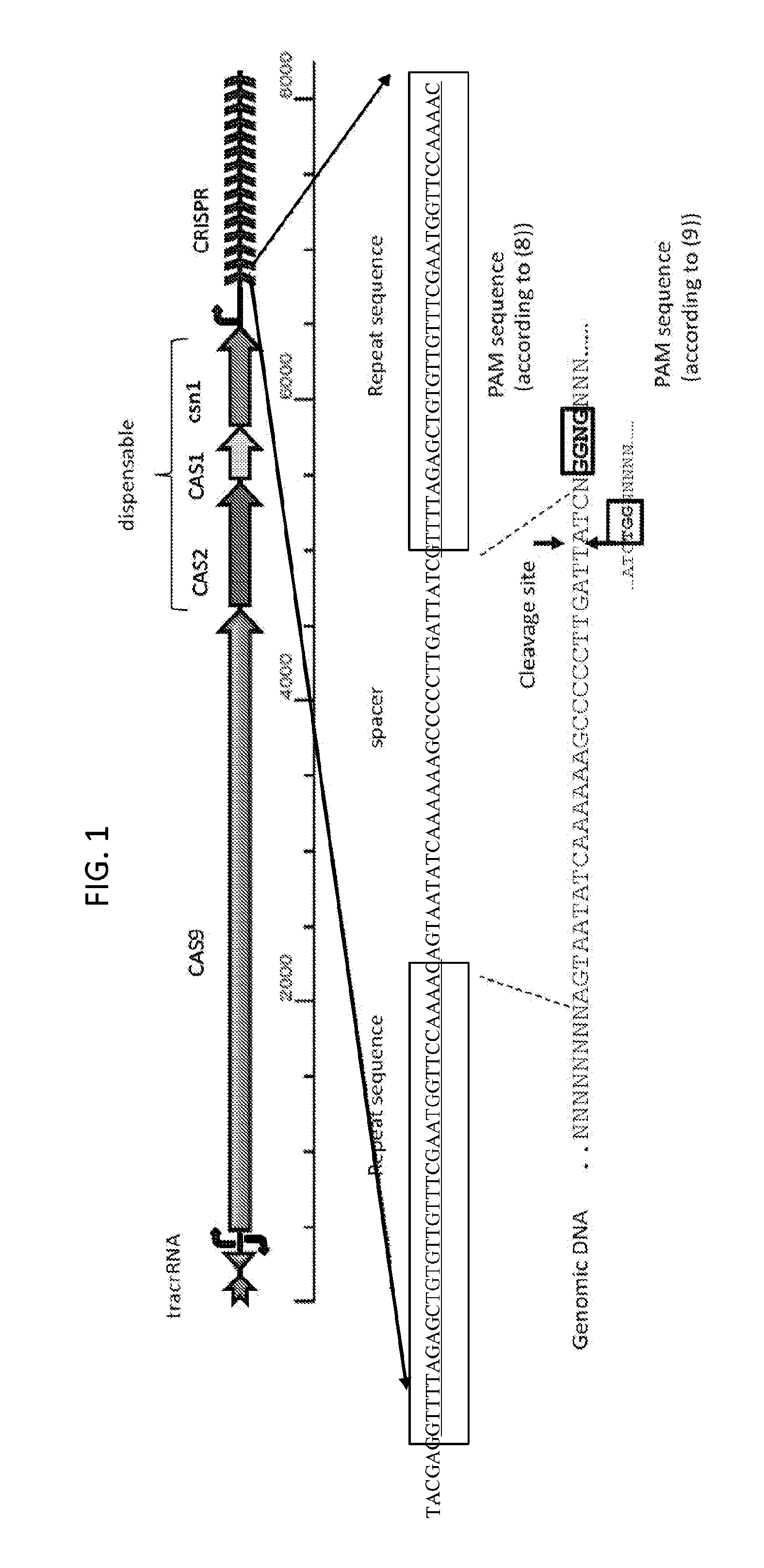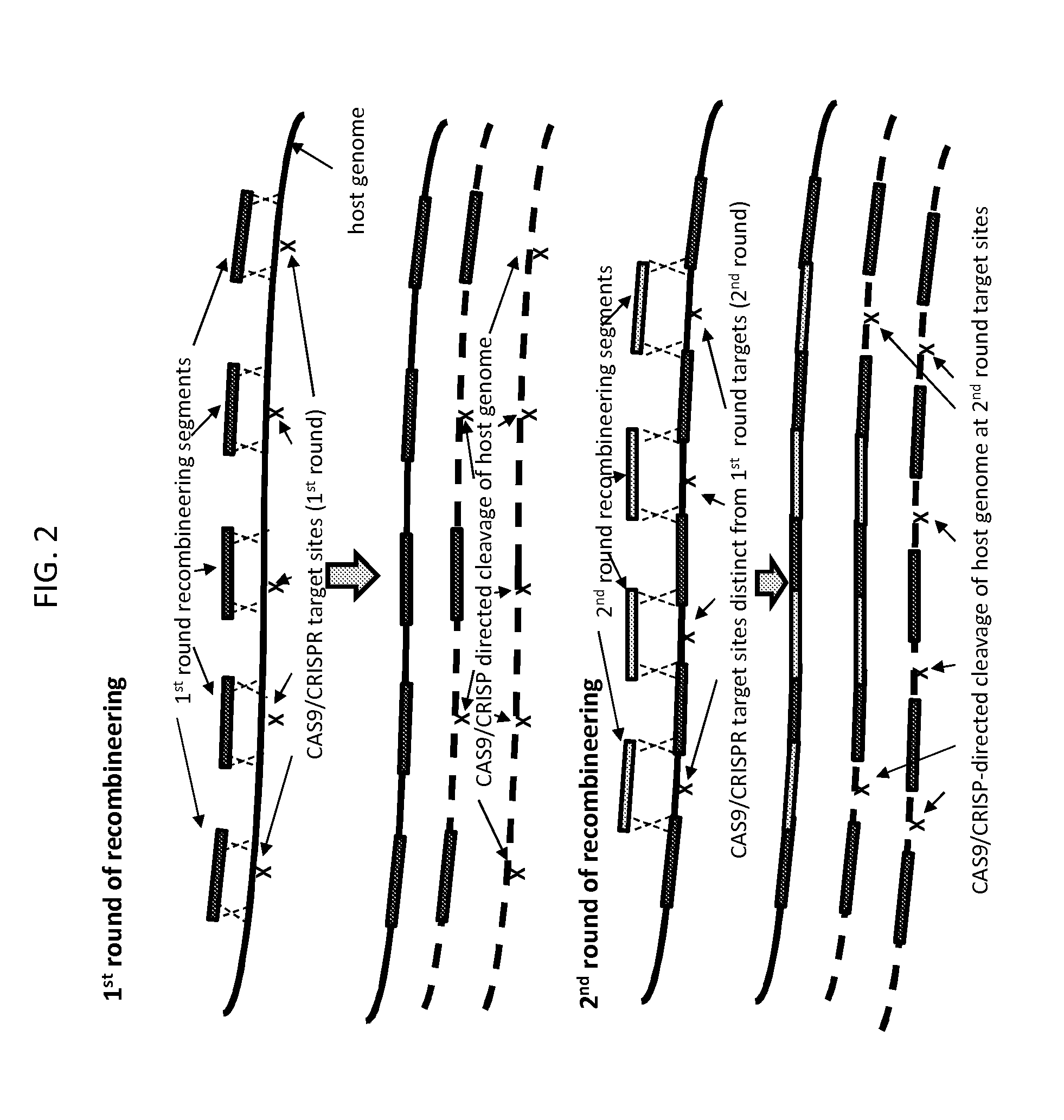Methods of in vivo engineering of large sequences using multiple crispr/cas selections of recombineering events
a sequence engineering and sequence technology, applied in the field of molecular biology, can solve the problems of inability to engineer long nucleic acid sequences, inability to recombine multiple events, and inability to achieve homologous recombination, so as to achieve the effect of minimizing the number of vectors and engineered spacer sequences and being easy to repla
- Summary
- Abstract
- Description
- Claims
- Application Information
AI Technical Summary
Benefits of technology
Problems solved by technology
Method used
Image
Examples
example 1
Practice of a Two-Round Production Method Based on Two Pre-Defined Cleavage Sequences and a CAS9 System
[0079]Because bacteria typically are not able to efficiently repair DNA double strand breaks (such as those generated by the CRISPR / CAS9 system), the present invention is easily practiced in bacteria, with a target nucleic acid being the bacterial chromosome. According to the present invention, the presence of any DNA sequence adjacent to a PAM element (in a CAS9-containing system, either TGG or NGGNG) can be specifically targeted to become a negative selectable (e.g., lethal) marker in the presence of a CAS9 system programmed to cleave that sequence. In the presence of the programmed CAS9 system, the host cell is expected to survive only if the targeted DNA sequence on the bacterial chromosome is replaced as the consequence of a successful recombineering event, and thus the protected from cleavage. In embodiments, the disclosed method involves cloning of at least one spacer sequen...
example 2
Multi-Round Engineering Method that Engineers Cleavage Sequences for Subsequent Rounds
[0086]FIG. 3 depicts another embodiment of the method of the invention, which encompasses the embodiment of FIG. 2 but extends it to allow for additional control of the process for creating an engineered sequence in a target nucleic acid.
[0087]In the embodiment depicted in FIG. 3, recombineering in rounds subsequent to round 1 does not rely exclusively on recombination at sequences present in previously integrated recombineering segments to integrate the recombineering segments into the target nucleic acid. Rather, recombineering can rely on recombination with two unaltered host target nucleic acid sequences or with one host target nucleic acid sequence and one previously integrated recombineering segment. In other words, the embodiment depicted in FIG. 3 relates to the method of the invention as it relates broadly to a multi-round recombineering / cleavage / selection method in which, in each round, o...
example 3
Control of Timing of Expression of CRISPR / Cas System
[0090]Because CRISPR / Cas9-induced double strand breaks can be lethal to the recombineering host when the target nucleic acid is the host chromosome, some embodiments of the present invention control the timing of expression of the CRISPR / Cas system such that those components are not expressed until after the recombineering event has occurred. This can in principle be achieved by first performing the recombineering reaction (e.g., transforming a λ-red / gam competent host with a linear DNA recombineering segment), allowing the recombineered cells to recover and the recombination event to occur, and then delivering a CRISPR / Cas9 expression vector to the host cell in a second round of transformation. Recombineering using double stranded DNA is typically not very efficient (usually 1 recombinant / 104 viable cells) and, aside from the inconvenience of producing competent cells from the recovery batch of the recombineering culture, transfor...
PUM
| Property | Measurement | Unit |
|---|---|---|
| temperatures | aaaaa | aaaaa |
| length | aaaaa | aaaaa |
| homologous recombination frequencies | aaaaa | aaaaa |
Abstract
Description
Claims
Application Information
 Login to View More
Login to View More - R&D
- Intellectual Property
- Life Sciences
- Materials
- Tech Scout
- Unparalleled Data Quality
- Higher Quality Content
- 60% Fewer Hallucinations
Browse by: Latest US Patents, China's latest patents, Technical Efficacy Thesaurus, Application Domain, Technology Topic, Popular Technical Reports.
© 2025 PatSnap. All rights reserved.Legal|Privacy policy|Modern Slavery Act Transparency Statement|Sitemap|About US| Contact US: help@patsnap.com



